Want to earn money while you sleep? Welcome to affiliate marketing!
If you’re an online publisher, content creator, or digital marketer, you can make commissions by promoting others’ products or services.
Does affiliate marketing pay well? Absolutely! In 2022, spending on affiliate marketing reached $8.2 million, steadily growing since 2010.
To succeed in social media affiliate marketing, you need the right platforms and strategies to beat algorithms and noise. That’s where we can help!
Table of Contents
Affiliate marketing on social media is a way to make money by sharing special links or discount codes in your posts. When people buy stuff using your links or codes, you earn cash.
Here’s how it works:
-
Share your affiliate links or codes in your posts and profiles.
-
When people use these links or codes to buy products, you get paid.
It sounds simple, but there’s more to it:
-
You can send your followers directly to the affiliate link.
-
Many affiliates have their own websites or online shops with these links.
-
Social media helps drive traffic to these links.
But, hold on, it’s not as easy as just sharing links everywhere. Building a following as an affiliate marketer can be tough. However, with the right strategy, you can make money from your content.
For instance:
Sean Garrette uses a Linktree in his Instagram bio to share affiliate links.

KarenBritChick, a New York influencer, shares affiliate links in her Instagram Stories. You can click the link sticker to shop right away or use her unique code at checkout.
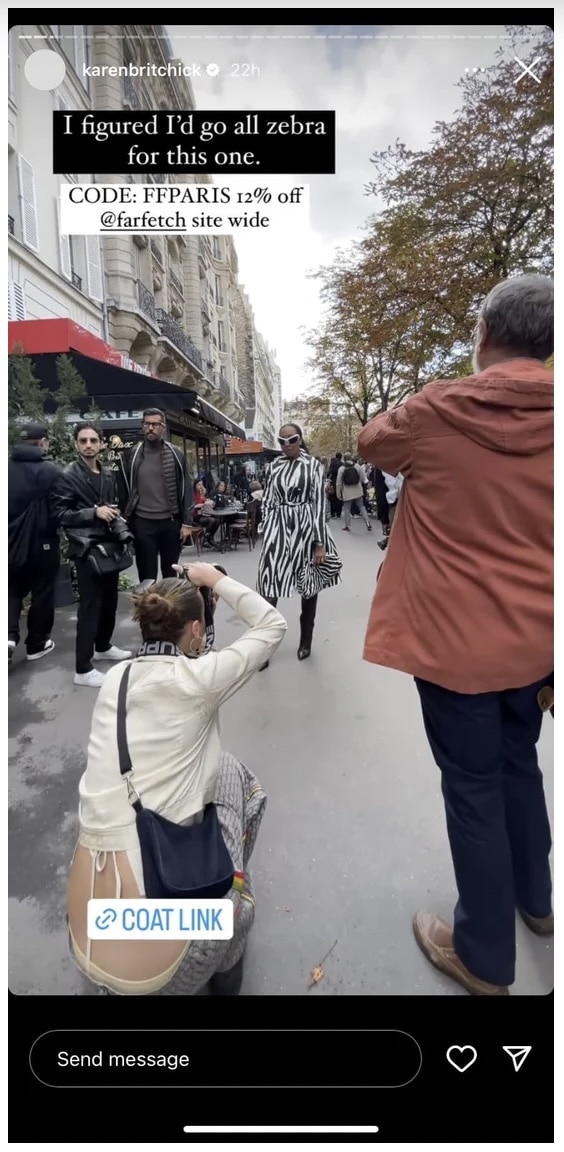
Many brands offer affiliate marketing, allowing content creators to earn commissions by recommending products and services they use. This makes it easy for them to naturally include product recommendations.
If you often recommend certain products, check if they have an affiliate program. If they do, you can earn money without needing the brand to notice or partner with you. If your recommendations lead to lots of sales, the brand might want to partner with you.
There’s a new way for creators to benefit from affiliate marketing on Instagram. Instagram is testing a native affiliate tool that’s not yet available to everyone. Once widely available, creators can tag products in their posts to earn commissions directly, without using affiliate links in their bio or a link tree.
To pick the right social media platform for affiliate marketing, consider your niche, goals, content style, and budget.
Each platform has its strengths and audience, so we’ve assessed them for traffic, audience size, and content creation ease to help you choose the best one for your affiliate strategy.
YouTube
As an affiliate marketer, your main aim is to persuade people to buy products and earn a commission in return. YouTube is a fantastic platform to achieve this goal.
YouTube is currently the second most popular social media platform worldwide, and it’s expected to reach nearly one billion users globally by 2025. It’s not just for entertainment – people visit their favorite YouTube channels to learn, gather information, and make buying decisions.
Here’s how it works as an affiliate marketing partner on YouTube: You create videos on your channel showcasing products, and you add tags to those products. These tags can contain affiliate links, and the commission rates can vary depending on the brand and retailer. You’ll typically find YouTube affiliate links for the featured products in the video description.
Note: YouTube also has its own affiliate marketing program. To be eligible for the YouTube Shopping affiliate program, you need to meet specific criteria, including being based in the US and having more than 20,000 channel subscribers.
YouTube affiliate marketing has several advantages for affiliates:
-
Videos are widely shared and can help you build a highly engaged audience.
-
Using videos for affiliate marketing allows you to earn passive income.
-
Optimizing your videos for SEO can boost your visibility on search engine results pages (SERPs) and drive more traffic.
-
Compelling product videos on YouTube have the potential for higher conversion rates compared to traditional content.
-
Many users turn to YouTube for purchasing decisions, with 68% watching videos related to their choices. Affiliate links in content like how-to videos connect users with featured products.
To create a successful YouTube content strategy for affiliate marketing, focus on showcasing affiliate products in an enjoyable and engaging manner. Here’s how:
- Trending Videos: Stay updated with the latest trends on the platform and create your unique version, including affiliate-recommended products.
-
Tutorials: Create content that explains how to solve problems, achieve goals, or use products effectively.
-
Comparisons: Compare two or more similar products to help viewers make informed choices.
-
Unboxings: Share the excitement of unpacking new products, particularly popular in beauty and tech niches.
-
Testimonials: Feature real-world customer experiences to build trust.
-
Buying Guides: Offer roundups of multiple products in a specific category for comprehensive guidance.
And remember, always include your affiliate link in the video description so viewers can easily click to the products you’re promoting.
Here’s an example: You can make a video showing how to install WordPress and include an affiliate link in the description.

In this case, the link can be “cloaked,” which means it’s redirected through the domain associated with your channel.
However, YouTube doesn’t have an issue with you using direct affiliate links in your video descriptions.

For more information, check out our guide on YouTube affiliate marketing.
Affiliate marketing on Twitter involves recommending products or services to your followers through free or paid tweets.
Twitter’s daily active user base is growing, and the platform offers numerous opportunities for engagement through real-time conversations.
Affiliate marketers can leverage this engagement by connecting conversations with relevant offers.
Although Twitter’s algorithm may bury links, you can still succeed by timing your posts well, creating intrigue, and building a loyal audience.

However, there are two key reasons why affiliate marketing is easier on Twitter compared to other platforms:
First, Instagram and Facebook have reduced organic reach, pushing users to pay for visibility. Twitter doesn’t aggressively promote paid tweets, giving even small accounts a chance to go viral with engaging content.
Second, Pew Research Center reports that only 10% of Twitter users create 80% of the content. This means there’s plenty of room to stand out and become a prominent voice on the platform.
Building credibility on Twitter involves strategically placing links on your profile and content. It’s crucial to find a balance:
- Don’t use too few links because your followers might miss them.
- Repetition is key since not all your followers will see a single tweet or retweet it.
- Avoid using too many links as it can make you appear salesy, which doesn’t work well in the long term.
The great thing about Twitter affiliate marketing is the flexibility to add your affiliate links anywhere without the hassle of bridge pages or links in your bio. This makes it easier to generate clicks and commissions.
For instance, you can strategically use your pinned tweet to promote affiliate products. A pinned tweet remains at the top of your profile at all times, ensuring your offer is front and center.
You can use your pinned tweet as a permanent feature for an evergreen offer, or you can switch it out based on the season, trends, or available offers.
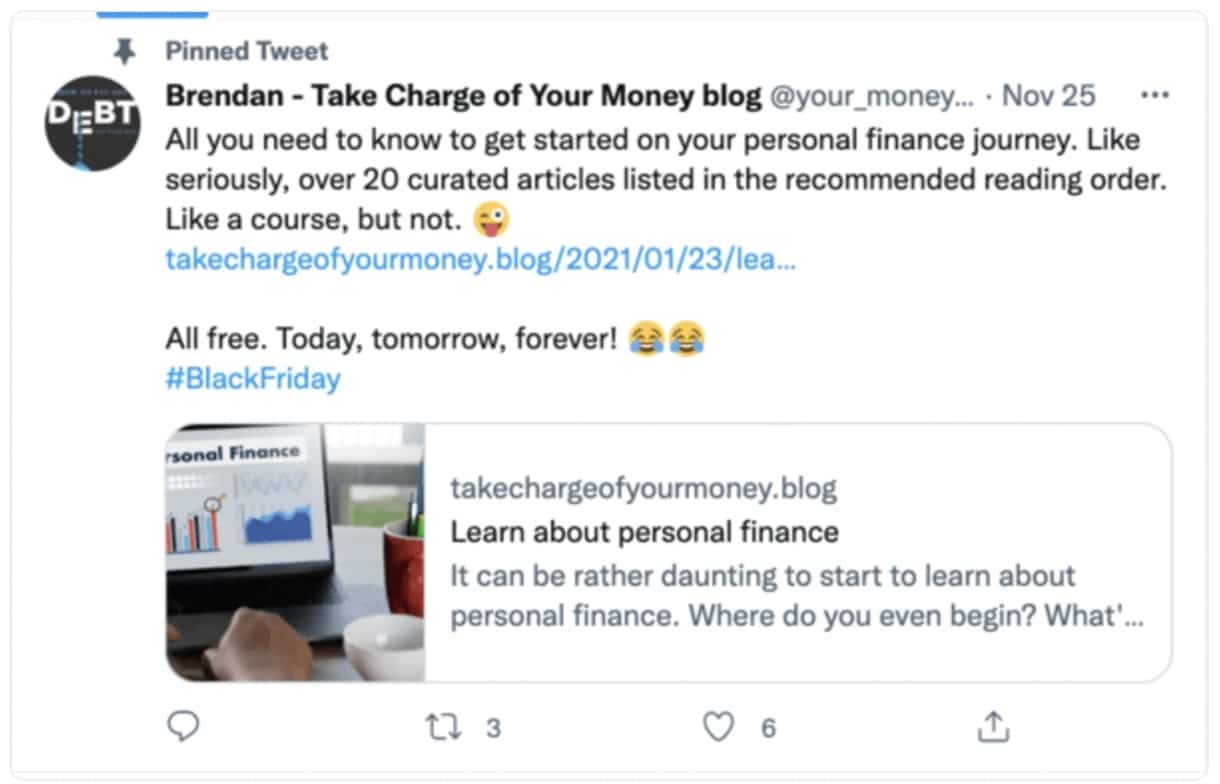
However, there’s a drawback: Twitter reduces your reach when you include links to external websites. That’s why Twitter affiliates often create content in threads, which are like microblogs on the platform. They place their affiliate links in the lower tweets, while the top tweets focus on driving engagement.
To learn more, check out our comprehensive guide on Twitter affiliate marketing.
TikTok
TikTok is a social media platform known for short-form video content. Just like other affiliate marketing programs, TikTok’s affiliate marketing can help retailers increase brand awareness and reach specific target audiences. It plays a crucial role in many brands’ TikTok marketing strategies.
While TikTok users can’t include clickable links in their videos, those with business accounts have options to promote affiliate offers. They can link directly to these offers on their TikTok profile pages or guide traffic to profiles on other social networks that are more link-friendly. Creators can also create videos that guide viewers to specific URLs, mention discount codes in video captions, or use paid TikTok advertising to expand their reach, encourage clicks, and increase their commission income.
Moreover, users with over 10,000 followers have the added benefit of adding clickable links to TikTok Stories. These are short videos featured on an account’s profile page and disappear after 24 hours.
Successful TikTok affiliate marketers use various methods to reach their audience. One effective approach is to tap into organic traffic on TikTok, and it appears that TikTok doesn’t limit the user traffic a creator can get. In fact, it’s possible to gain tens of millions of followers without any cost.
Here are a few ways to make the most of organic traffic on TikTok:
- Promote coupon codes or URLs in your videos.
- Link to a URL from your profile.
- Include an affiliate URL in your content description.
- Redirect traffic to your other social profiles.
Now, let’s explore how you can use these options to your advantage:
Method #1: Promote Coupon Codes
Many advertisers are willing to provide TikTok affiliate marketers with discounts or coupon codes. You can mention these codes briefly in your videos or even receive a dedicated referral URL for their affiliate program.
Method #2: Link to an External URL
While TikTok’s policy on adding links to videos can be inconsistent, there are workarounds. You can upgrade to a business account to link directly to your blog or website from your TikTok profile. Alternatively, you can use a bridging page like LinkTree to drive traffic to multiple affiliate offer links or URLs without needing a business account.
Method #3: Add a URL to Your Description
Though a bit less user-friendly, some influencers on TikTok include affiliate offer links in their content descriptions. This method relies on followers copying and pasting the affiliate URL into their browsers.
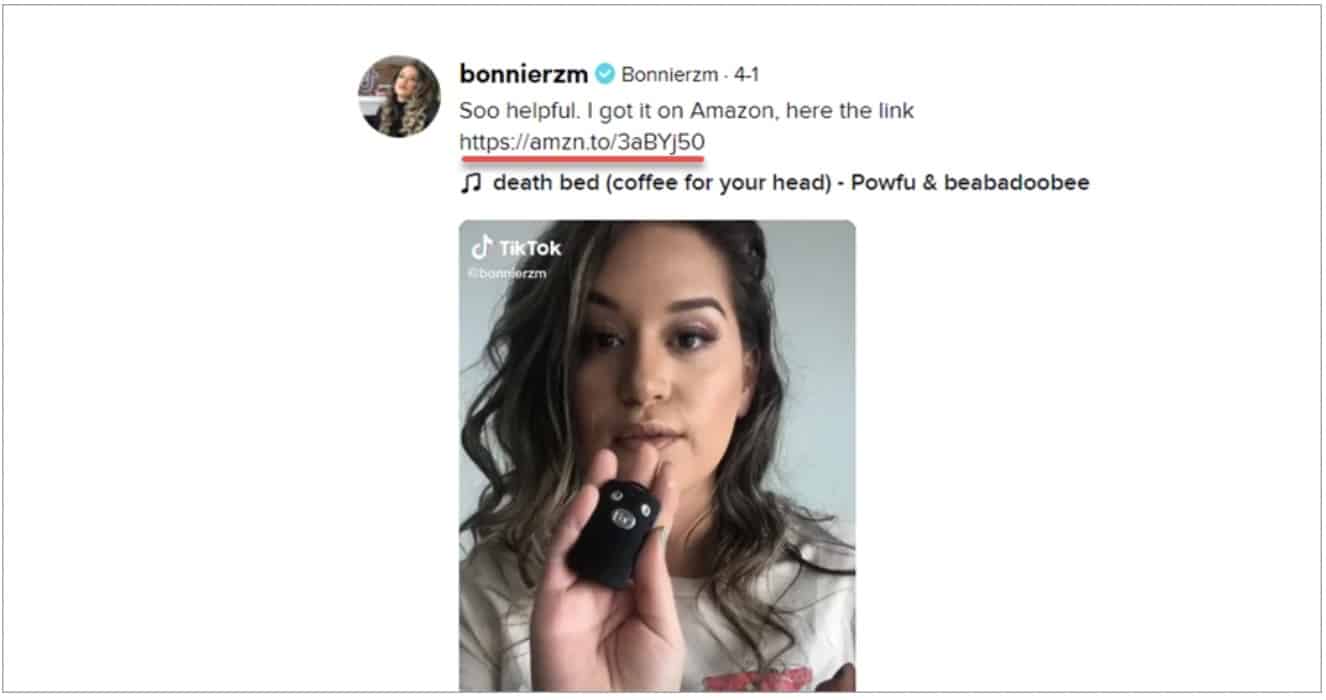
Method #4: Link to Your Other Social Platforms
On TikTok, it’s easy to link to your other social media platforms. You can customize your profile and set up these links in less than a minute.
Ready to get started? Check out our guide on TikTok affiliate marketing.
Instagram Affiliate Marketing
Instagram affiliate marketing is when influencers on Instagram earn money by promoting a brand. They get paid when people click their special link or use their discount code to buy products.
This type of marketing is so popular. In fact, 61.4% of affiliate marketers use Instagram to promote stuff, as per our stats.
What’s cool is that Instagram is the top choice for most influencers, and around 70% of Millennials trust influencers’ opinions the most.
Influencers have a big impact on brand awareness. So, people often check Instagram for product reviews.
That’s why it’s smart for affiliate marketers to try Instagram. It’s a unique platform with lots of potential.
On Instagram, you can add affiliate links to
- Instagram Stories
- Image description
- Instagram bio
Now, let’s take a look at the nitty-gritties of doing so:
Method #1: Swipe-Up In Instagram Stories
Let’s take Everyday Carry as an example. They have 279k followers. It might not be as big as celebrities with 20 million followers, but for affiliate marketers, it’s a significant and focused audience to make money with different products and services.
You may have noticed they have “Instagram Stories” categories above their posts. When you tap on one, you see related images. For example, I tapped on “Survival pens.”
If I swipe up to “See More,” it takes me to the Everyday Carry blog. There, I find reviews of the best tactical pens with links to Amazon to buy them. When I make a purchase, the blog owner earns a commission from the traffic sent from their Instagram account to their blog.
This is how Instagram affiliate marketing works. But to use the swipe-up feature, you need an Instagram Business account with at least 10,000 followers. It’s free and offers other benefits like marketing data insights. Remember this for future reference.
Method #2: In Your Image Description
Instead of placing your affiliate link directly in your image description, consider a different approach. Typically, you can’t click on such links to go directly to the product page, which can be inconvenient for your visitors.
Here’s an example of how a Star Wars collectibles affiliate marketer handles this:
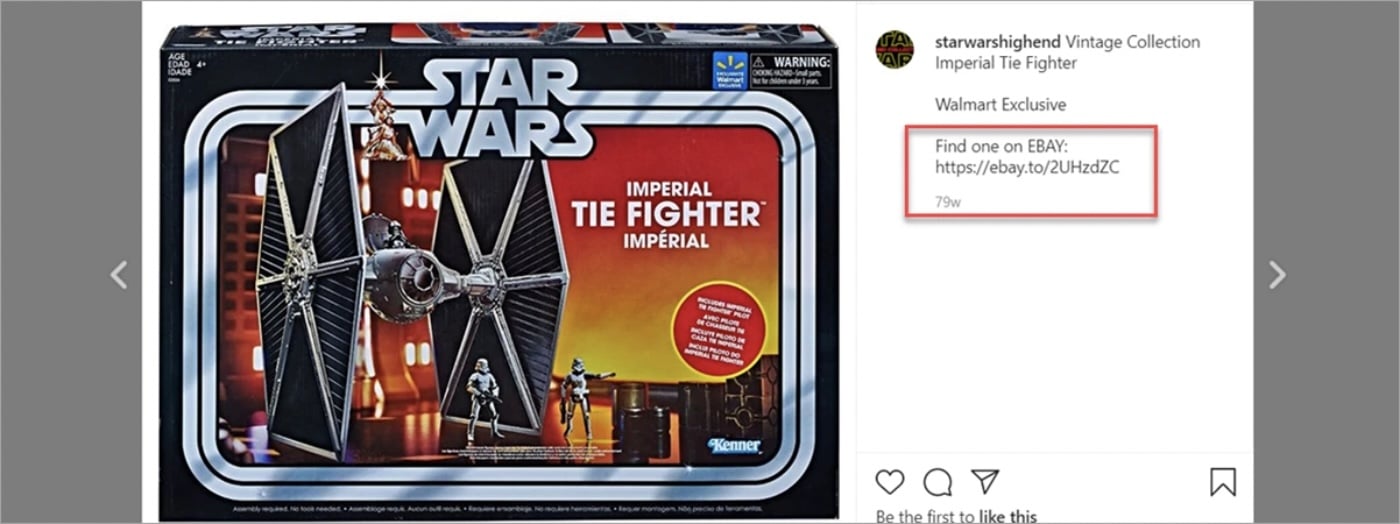
They include a link that leads to an eBay page listing Tie Fighters for sale. However, the downside is that this link isn’t clickable.
To access the product, your followers would need to copy and paste the link into their web browser. Star Wars enthusiasts might be willing to do this, but it might be less appealing to others.
Method #3: In Your Instagram Bio
The “link in the bio” strategy works great if you’re focusing on promoting just one affiliate program or directing followers to your blog.
For instance, Everyday Carry does this effectively.
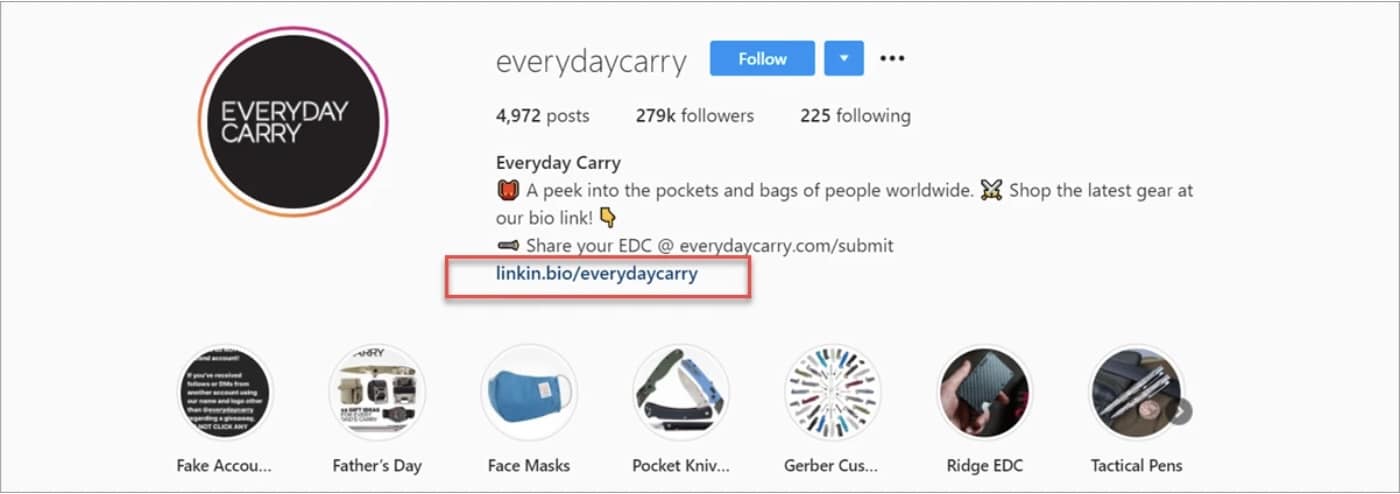
They use a service called Linkin.bio by Later.com, which transforms your Instagram feed into a landing page with clickable images.
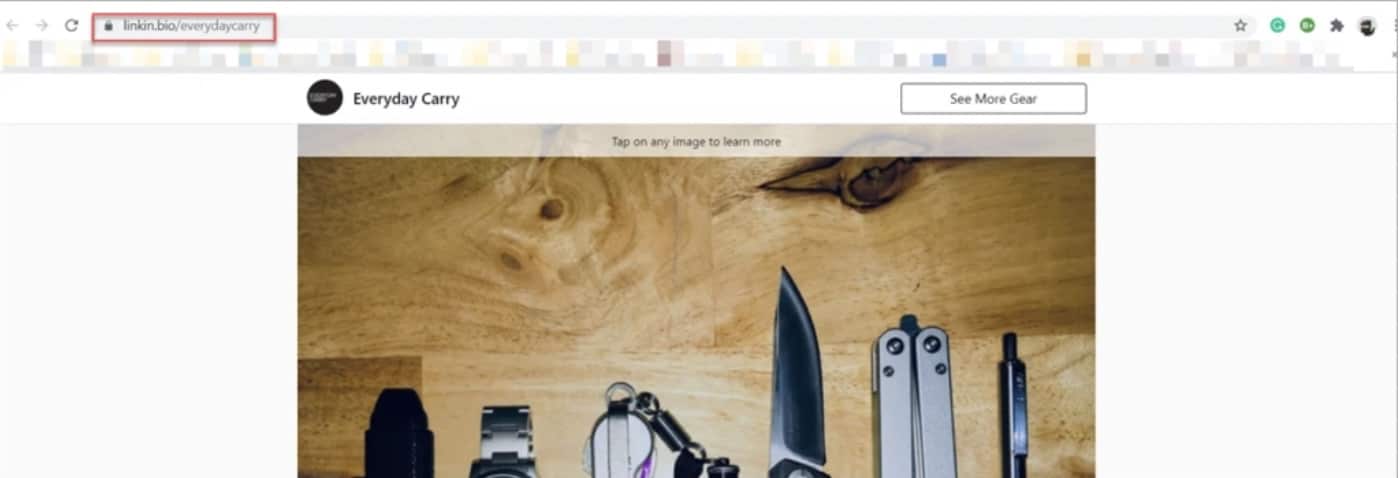
Each image can then lead to your blog or affiliate offers.
You can either use this service (it offers free and paid options) or insert a short affiliate link in your bio. The catch is, you can only have one link in your bio at a time.
So, you’ll need to switch between different affiliate marketing programs or consider using Linkin.bio for a more versatile approach.
For more information, check out our guide on Instagram affiliate marketing.
Facebook Affiliate Marketing
Facebook affiliate marketing lets marketers use Facebook’s vast reach to drive traffic to a Facebook page, group, or external website.
Facebook has a massive audience of 2.7 billion users, making it the largest social media platform and a favorite among affiliate marketers.
According to affiliate marketing statistics, 75.8% of them use Facebook for traffic and promotions.
On Facebook, there are three ways to boost affiliate link clicks:
Method #1: Leverage organic traffic
You probably have a Facebook profile with lots of friends. It might seem like a good idea to post content there with affiliate links, right? Well, not really.
Posting affiliate links on your profile is not the best way to do Facebook affiliate marketing. Your friends likely see many such requests, and most of them get ignored or deleted.
This approach won’t trigger Facebook’s algorithm to get you organic traffic. In fact, Facebook limits that kind of traffic.
So, asking for page likes and shares won’t help much either. Instead, focus on creating engaging content that people might share naturally.
A tip: Facebook posts with photos get 53% more likes and 104% more comments, so use visuals to your advantage. Platforms like Adcreative AI can help you generate compelling images for your social media efforts.
Method #2: Piggyback on Facebook group or pages
Facebook has countless groups and pages for various hobbies and interests, many with millions of members. You can use these existing audiences to boost your affiliate marketing business.
A smart approach is to find related groups. For instance, if you’re into Star Wars collectibles, explore sci-fi groups or pages. Here’s an example:

When you join a Facebook group, focus on giving, not taking.
Share funny, unique, and creative content without expecting anything in return.
Stand out, but don’t come across as trying to take over. The group owner will see you as a valuable member.
When you do share your own links, they’re more likely to be approved.
Method #3: Use paid ads
Organic traffic can only take you so far though.
In the same way that relying on “word of mouth” referrals isn’t a business plan, it’s a “hope”.
That’s why your long-term affiliate marketing plan should include paid Facebook ads.
You can do this by either boosting Facebook posts or using the ‘Ad Manager’:
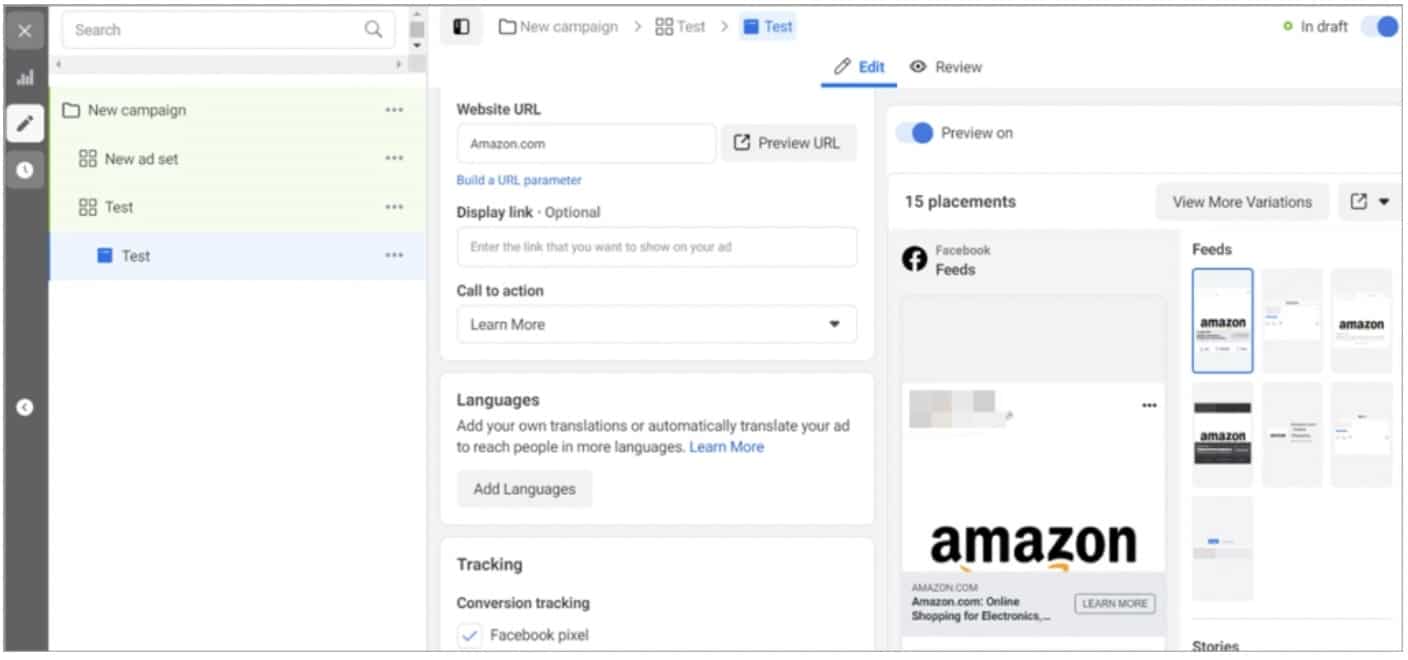
If you want to create an ad that specifically targets people living in the UK, between the ages of 21 and 55, who also like Star Wars, it only takes just minutes to set up such a campaign.

There are three main ways to use paid ads in your Facebook affiliate campaigns:
- Directly link from your Facebook posts to affiliate offers.
- Drive traffic to products and services for a given affiliate program on your website.
- Boost the engagement of your new or existing Facebook posts.
For example, you could write an engaging post that contains a link to your blog and then boost that post to reach tens of millions of potential customers.
However, it’s important to choose high-paying affiliate offers to make up for the money spent on Facebook ads; otherwise, you might end up running at a loss.”
For more information, check out our guide on Facebook affiliate marketing.
Pinterest Affiliate Marketing
Pinterest is a social media network and search engine where users can explore new products and ideas through images called “pins.” These pins are linked to external websites. Users save these pins to their boards, creating virtual mood boards.
Pinterest affiliate marketing involves sharing “affiliate pins” that contain links to products. When people click on these pins and make a purchase, the person sharing the pin earns a commission.
As an affiliate marketer, you can use Pinterest to drive traffic to your affiliate content, like blog posts, affiliate landing pages, or YouTube videos. Just like other affiliate programs, such as YouTube and Shopify affiliate marketing, the more people who see your link, the better chance you have of making sales and earning commissions.
Pinterest is more than just a social media platform; it’s a visual search engine. According to Pinterest, 80% of users discover new brands and products on the platform every week, making it a valuable channel for marketers in affiliate programs.
The latest popular trends on Pinterest include nails, easy dinner recipes, and outfit ideas. Pinterest also predicts that beauty, celebrations, fashion, hobbies and interests, and home-related content will be trending soon.
There are two main ways to use Pinterest for affiliate marketing:
Method #1: Link Directly To Affiliate Offers
To use Pinterest for affiliate marketing, you don’t have to create a website. You can simply add affiliate links to your pins, and when people make purchases through these links, you’ll earn money. Pinterest allows this, but it’s important to be clear about your intentions.
Example: CabyCades, an Amazon affiliate, uses video pins to promote products. When someone clicks the Amazon link in the pin and makes a purchase, CabyCades earns a commission.

This profile gets 16.5k monthly views and is basically just a collection of very short videos with Amazon links.
The idea is that anyone can do this.
For example, they’re selling a product that uses a real human voice to make a “shushing” sound to help babies sleep.
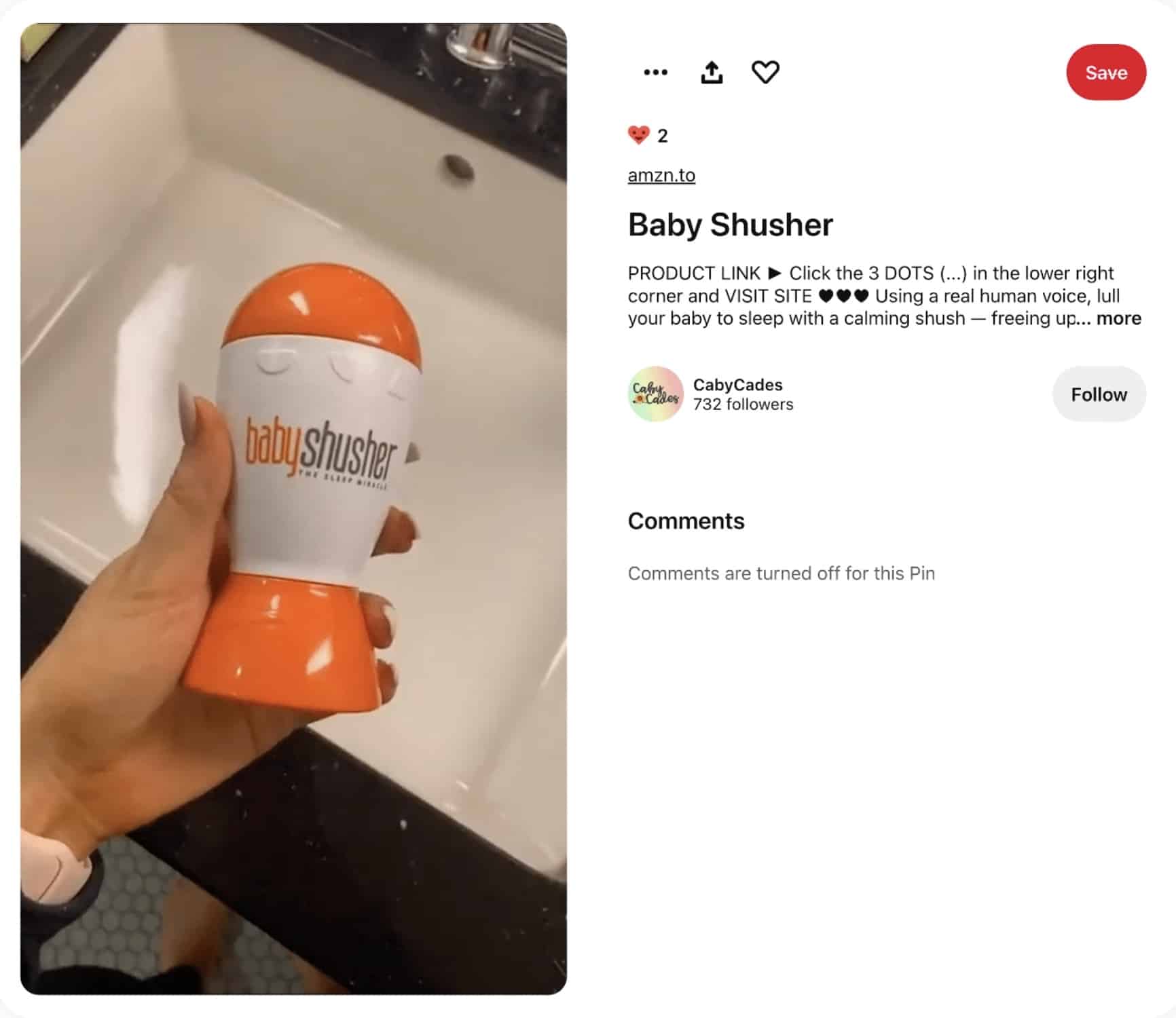
They made a quick 14-second video explaining how the product works, and every time someone buys it, they earn a commission.
Method #2: Drive Traffic To An Affiliate Link In A Blog
To succeed in Pinterest affiliate marketing over the long term, consider creating a blog. While it may require more initial effort, it can lead to better results in terms of conversions.
Example: Look at Stephanie’s Sweet Treats, a food blog that leverages Pinterest and social media to increase the visibility of her content and earn higher commissions.
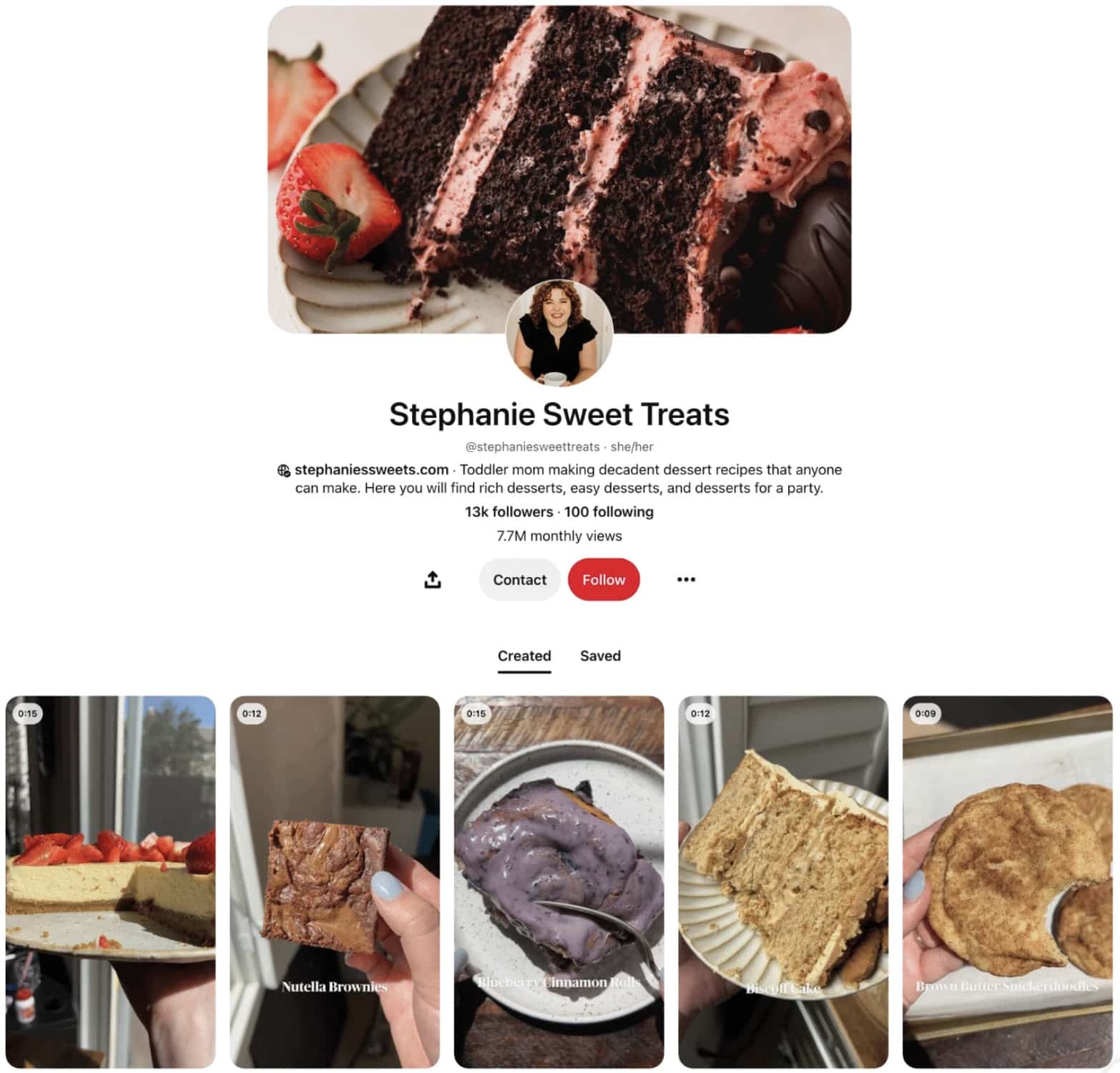
This profile has over 15,000 pins, attracting a monthly audience of 7.7 million views.
Stephanie’s blog uses captivating visuals to grab the attention of those searching for baking recipes.
What’s more, Stephanie’s Sweet Treats even shares a 2022 food blog income report, detailing how she made $128,000 from her food blog.
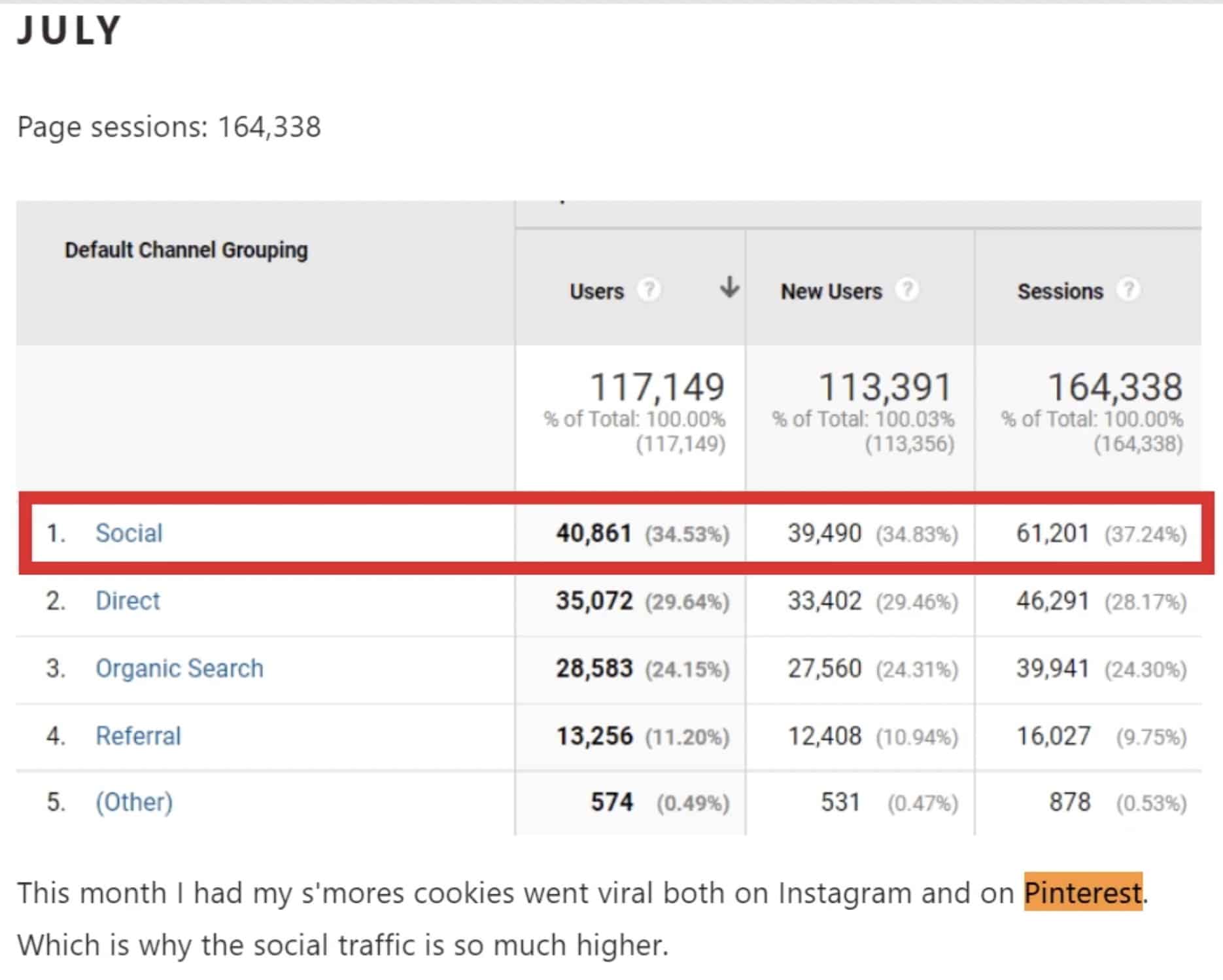
For more information, check out our guide on Pinterest affiliate marketing.
Selecting the right social media platform for your specific audience is crucial.
For instance, if you want to reach Gen Z gamers, Facebook may not be the best choice because your target audience is a small fraction of its users. Instead, consider TikTok, where nearly 40% of users are between 18 and 24 years old, and 82% of them play games at least once a week.
Here are some guidelines to help you pick the right social media channels for your affiliate marketing strategy:
| Criteria | Key Considerations |
|---|---|
| Suitability for Affiliate Marketing |
|
| Audience Size & Demographics |
|
| Top-Performing Content Types |
|
| In-Niche Competition |
|
| Organic Reach & Engagement |
|
| Paid Advertising |
|
Believe us, no matter how unique your niche and audience are, there’s a social platform that suits your needs.
Once you’ve discovered the right one, it’s time to launch your business. Start by researching affiliate programs, building your affiliate website, and crafting engaging content. Learn more about the next steps in our comprehensive guide on starting an affiliate marketing business.
Final Words
Social media affiliate marketing is a powerful way to use social media to generate sales, increase traffic, and build your brand.
However, social media trends change rapidly, and algorithms can be unpredictable. So, relying solely on social platforms for a steady income can be challenging.
Instead, we recommend using social media as one of several ways to drive traffic to your website. Combine it with email marketing, podcasts, SEO, and paid ads for better results.
If you need more guidance, sign up for my online business coaching.

Jeff Smith, Founder of High Income Source, is an online business coach with a BBA in Marketing and Entrepreneurship from the University of Pennsylvania. His online business coaching program is so popular that more than 100 students have benefited and started successful online businesses under his guidance.
Jeff started dabbling in online business while he was in college, where he began with dropshipping. After college, Jeff worked at a marketing agency and freelanced as a writer. His breakthrough came when he realized the potential of blogging, leading to a $100,000 sale of a dog-focused website. His expertise includes SEO, affiliate marketing, Amazon FBA, blogging and dropshipping.